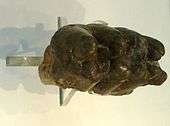Tetralophodon
Tetralophodon ("four-ridged tooth") is an extinct elephantoid genus belonging to the family Anancidae.[2][3][4]
| Tetralophodon | |
|---|---|
 | |
| Mounted skeleton, Henan Geological Museum | |
| Scientific classification | |
| Kingdom: | Animalia |
| Phylum: | Chordata |
| Class: | Mammalia |
| Order: | Proboscidea |
| Family: | †Anancidae |
| Genus: | †Tetralophodon Falconer & Cautley, 1847 |
| Species | |
Taxonomy
The genus Tetralophodon (meaning "four-ridged tooth") was named in the mid-19th century with the discovery of the specialized teeth.
Description
Tetralophodon was an elephant-like animal which existed through the late Miocene to the Middle Pliocene epochs,[5] approximately 10.9 million years.
Like the gomphotheres, to which it was not closely related, Tetralophodon had four tusks and a trunk. They are believed to have been about 2.58–3.45 m (8.5–11.3 ft) tall at the shoulder and up to 10 tonnes in weight,[6] larger than the size of the present Asian elephant, with a long trunk and incisors ranging up to 2 m (6.6 ft) long. These incisors are believed to have been used as a defense mechanism.
The large, four-cusped cheek teeth of these animals are about 60 mm (2.4 in) by 80 mm (3.1 in), about six times the size of a normal human tooth. These low-crowned, bunodont teeth were adapted for crushing and grinding, compared with other mammals during this era that had sharp teeth used for cutting. The teeth indicate a diet of large fruits and vegetables. This diet was aided by the large size and long trunks that enabled these mammals to reach tall, fruit-bearing trees.
Some features, mainly concerning the teeth, would seem to place Tetralophodon close to the origin of today's elephants. The molars, in particular, are more advanced and specialized than those of the other gomphotheres.
Distribution

These animals were very widespread and successful proboscideans. Their fossils have been found from the late Miocene to the Middle Pliocene epochs of Europe, Asia, and Africa. Most fossil records of Tetralophodon are of four-ridged teeth. The North American species, T. campester and T. fricki, have been moved to the genus Pediolophodon in 2007.[7]
The majority of the gomphotheres became extinct at the end of the Pleistocene. While the reason for this extinction is still debated, what is known is that these massive elephantoids under the genus Tetralophodon did not survive.[7]
References
- Shi-Qi Wang; Haruo Saegusa; Jaroon Duangkrayom; Wen He; Shan-Qin Chen (2017). "A new species of Tetralophodon from the Linxia Basin and the biostratigraphic significance of tetralophodont gomphotheres from the Upper Miocene of northern China". Palaeoworld. in press. doi:10.1016/j.palwor.2017.03.005
- J. Shoshani and P. Tassy. 2005. Advances in proboscidean taxonomy & classification, anatomy & physiology, and ecology & behavior. Quaternary International 126-128:5-20
- J. Shoshani and P. Tassy. 1996. Summary, conclusions, and a glimpse into the future. in J. Shoshani and P. Tassy, eds., The Proboscidea: Evolution and Palaeoecology of Elephants and Their Relatives 335-348
- Mothé D, Ferretti MP, Avilla LS (2016) "The Dance of Tusks: Rediscovery of Lower Incisors in the Pan-American Proboscidean Cuvieronius hyodon Revises Incisor Evolution in Elephantimorpha". PLoS ONE 11(1): e0147009. doi:10.1371/journal.pone.0147009
- "ON THE SUBDIVISIONS AND EVOLUTION OF THE QUATERNARY MAMMALIAN FAUNAS OF SOUTH CHINA--《Certebrata Palasiatica》1981年01期". en.cnki.com.cn. Retrieved 2016-06-12.
- Larramendi, A. (2016). "Shoulder height, body mass and shape of proboscideans" (PDF). Acta Palaeontologica Polonica. 61. doi:10.4202/app.00136.2014.
- Lambert, W. D. (2007). "New tetralophodont gomphothere material from Nebraska and its implications for the status of North American Tetralophodon". Journal of Vertebrate Paleontology. 27 (3): 676–682. doi:10.1671/0272-4634(2007)27[676:NTGMFN]2.0.CO;2.